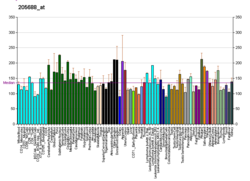Transcription factor AP-4 (activating enhancer binding protein 4), also known as TFAP4, is a protein which in humans is encoded by the TFAP4 gene.
Function
Transcription factor AP4 is a member of the basic helix-loop-helix (bHLH) transcription factors, which bind to the E-box sequence in the promoters of their target genes. AP-4 has been shown to act both as a repressor and an activator for different target genes.
References
- ^ GRCh38: Ensembl release 89: ENSG00000090447 – Ensembl, May 2017
- ^ GRCm38: Ensembl release 89: ENSMUSG00000005718 – Ensembl, May 2017
- "Human PubMed Reference:". National Center for Biotechnology Information, U.S. National Library of Medicine.
- "Mouse PubMed Reference:". National Center for Biotechnology Information, U.S. National Library of Medicine.
- "Entrez Gene: TFAP4 transcription factor AP-4 (activating enhancer binding protein 4)".
Further reading
- Hu YF, Lüscher B, Admon A, et al. (1991). "Transcription factor AP-4 contains multiple dimerization domains that regulate dimer specificity". Genes Dev. 4 (10): 1741–52. doi:10.1101/gad.4.10.1741. PMID 2123466.
- Mermod N, Williams TJ, Tjian R (1988). "Enhancer binding factors AP-4 and AP-1 act in concert to activate SV40 late transcription in vitro". Nature. 332 (6164): 557–61. Bibcode:1988Natur.332..557M. doi:10.1038/332557a0. PMID 2833704. S2CID 4340282.
- Ou SH, Garcia-Martínez LF, Paulssen EJ, Gaynor RB (1994). "Role of flanking E box motifs in human immunodeficiency virus type 1 TATA element function". J. Virol. 68 (11): 7188–99. doi:10.1128/JVI.68.11.7188-7199.1994. PMC 237158. PMID 7933101.
- Lewis TB, Wood S, Michaelis EK, et al. (1996). "Localization of a gene for a glutamate binding subunit of a NMDA receptor (GRINA) to 8q24". Genomics. 32 (1): 131–3. doi:10.1006/geno.1996.0088. PMID 8786101.
- Petersenn S, Rasch AC, Heyens M, Schulte HM (1998). "Structure and regulation of the human growth hormone-releasing hormone receptor gene". Mol. Endocrinol. 12 (2): 233–47. doi:10.1210/mend.12.2.0057. PMID 9482665.
- King-Jones K, Korge G, Lehmann M (1999). "The helix-loop-helix proteins dAP-4 and daughterless bind both in vitro and in vivo to SEBP3 sites required for transcriptional activation of the Drosophila gene Sgs-4". J. Mol. Biol. 291 (1): 71–82. doi:10.1006/jmbi.1999.2963. PMID 10438607.
- Strausberg RL, Feingold EA, Grouse LH, et al. (2003). "Generation and initial analysis of more than 15,000 full-length human and mouse cDNA sequences". Proc. Natl. Acad. Sci. U.S.A. 99 (26): 16899–903. Bibcode:2002PNAS...9916899M. doi:10.1073/pnas.242603899. PMC 139241. PMID 12477932.
- Beausoleil SA, Jedrychowski M, Schwartz D, et al. (2004). "Large-scale characterization of HeLa cell nuclear phosphoproteins". Proc. Natl. Acad. Sci. U.S.A. 101 (33): 12130–5. Bibcode:2004PNAS..10112130B. doi:10.1073/pnas.0404720101. PMC 514446. PMID 15302935.
- Gerhard DS, Wagner L, Feingold EA, et al. (2004). "The Status, Quality, and Expansion of the NIH Full-Length cDNA Project: The Mammalian Gene Collection (MGC)". Genome Res. 14 (10B): 2121–7. doi:10.1101/gr.2596504. PMC 528928. PMID 15489334.
- Martin J, Han C, Gordon LA, et al. (2005). "The sequence and analysis of duplication-rich human chromosome 16" (PDF). Nature. 432 (7020): 988–94. Bibcode:2004Natur.432..988M. doi:10.1038/nature03187. PMID 15616553. S2CID 4362044.
- Olsen JV, Blagoev B, Gnad F, et al. (2006). "Global, in vivo, and site-specific phosphorylation dynamics in signaling networks". Cell. 127 (3): 635–48. doi:10.1016/j.cell.2006.09.026. PMID 17081983.
External links
- TFAP4+protein,+human at the U.S. National Library of Medicine Medical Subject Headings (MeSH)
This article incorporates text from the United States National Library of Medicine, which is in the public domain.
| Transcription factors and intracellular receptors | |||||||||||||||||||||||||||||||
|---|---|---|---|---|---|---|---|---|---|---|---|---|---|---|---|---|---|---|---|---|---|---|---|---|---|---|---|---|---|---|---|
| |||||||||||||||||||||||||||||||
| |||||||||||||||||||||||||||||||
| |||||||||||||||||||||||||||||||
| |||||||||||||||||||||||||||||||
| |||||||||||||||||||||||||||||||
| see also transcription factor/coregulator deficiencies | |||||||||||||||||||||||||||||||
This article on a gene on human chromosome 16 is a stub. You can help Misplaced Pages by expanding it. |




